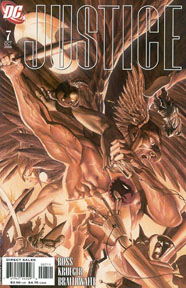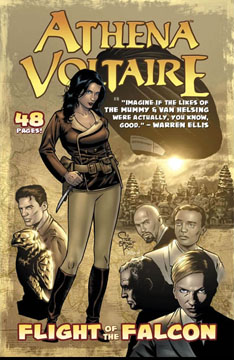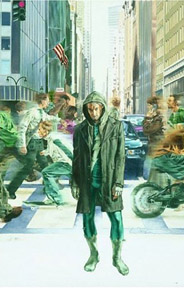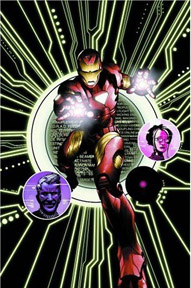Ding, dong, the Wizard is dead, let The Trials of Shazam! begin.
By Graig
 It’s almost inconceivable that at one point the adventures of Captain Marvel used to outsell those of Superman (and everyone else in fact), especially considering the character hasn’t been able to sustain a prolonged series since DC comics sued the stretchy pants off of Fawcett and settled out of court in the early 1950’s. Being out of publication for two decades and missing out on two generations of children didn’t solidify the legacy of the character any, and when DC licensed the Fawcett characters in the early 1970’s, they had to do so under the “Shazam” moniker, since Captain Marvel was trademarked by Marvel Comics (the public generally knows the character by the “Shazam” title and not his actual name). It’s been and up and down roller coaster ever since, mainly because DC hasn’t ever really known what to do with the character. He’s certainly classic, and iconic, but the appeal of the character is supposed to swing to a younger demographic (a teenager turns into the World’s Mightiest Mortal is pure juvenile fantasy), and comics have, since the 1970’s, been swinging further and further away from a pre-teen market.
It’s almost inconceivable that at one point the adventures of Captain Marvel used to outsell those of Superman (and everyone else in fact), especially considering the character hasn’t been able to sustain a prolonged series since DC comics sued the stretchy pants off of Fawcett and settled out of court in the early 1950’s. Being out of publication for two decades and missing out on two generations of children didn’t solidify the legacy of the character any, and when DC licensed the Fawcett characters in the early 1970’s, they had to do so under the “Shazam” moniker, since Captain Marvel was trademarked by Marvel Comics (the public generally knows the character by the “Shazam” title and not his actual name). It’s been and up and down roller coaster ever since, mainly because DC hasn’t ever really known what to do with the character. He’s certainly classic, and iconic, but the appeal of the character is supposed to swing to a younger demographic (a teenager turns into the World’s Mightiest Mortal is pure juvenile fantasy), and comics have, since the 1970’s, been swinging further and further away from a pre-teen market.
This leads us to the latest incarnation of Captain Marvel. With the Wizard Shazam dead following the events of Infinite Crisis, Cap’s alter ego, Billy Batson, has taken up the role as guardian of the Rock Of Eternity, housing the Seven Deadly Sins. As seen in 52, the Sins, as much as the gods represented by the “SHAZAM” mantra, speak to Billy, driving him a little batty. But by the time The Trials of Shazam! comes about, Billy has regained his sanity and a few new skills, and he’s taken it upon himself to be the watchdog of the new magic that’s arisen since Crisis and Day of Vengeance. Freddy Freeman and Billy’s sister Mary Batson (the former Captain Marvel Jr. and Mary Marvel, respectively) are now powerless, but Freddy isn’t ready to accept regular life just yet.
Written by Judd Winick, The Trials of Shazam! definitely takes a new turn for the character, and it’s somewhat of an uncomfortable fit. Much of the first issue feels more like early Hellboy than it does Captain Marvel, with a healthy dose of Lovecraftian monsters and Dungeons & Dragons-esque fantasy scattered throughout. But I suppose if that’s the direction they wish to take, then it’s best to step both feet in at once. It’s not how I envision the character, but then magic and fantasy aren’t really my bag.
Howard Porter handles the artistic chores, testing out new coloring effects that recalls Dan Brereton’s technique only less stylish and skilled. Porter has never been a favorite artist of mine, and he seemed to have achieved a certain status as a comic book artist without having the qualities that really define a superstar. Though he does do a competent job storytelling, he was never the right choice to work with Morrison on JLA, he was the wrong artist for the Flash, and here, for my money, he’s not the right person to work the Marvel family. Actually, looking at his work I’m reminded of Todd McFarlane, another artist whose work I never cared for but achieved a prominent status, as they share a similar flat line to their panels and characters.
The Trials of Shazam! is not a book I’m going to like, but at the same time I recognize there’s a market of magic and fantasy fans who really might dig this melding with prominent superheroes.
RATING: 
Crisis? We Don’t Need No Stinkin’ Crisis. All-Star Superman #5 and Justice #7
By Jeb D.
 It’s interesting—maybe borderline ironic—that, after all the effort DC has put into rejiggering their universe recently, with Infinite Crisis and its various spinoffs, some of the best—and best-selling—spandex titles they have these days are the ones specifically designed to exist out of regular continuity.
It’s interesting—maybe borderline ironic—that, after all the effort DC has put into rejiggering their universe recently, with Infinite Crisis and its various spinoffs, some of the best—and best-selling—spandex titles they have these days are the ones specifically designed to exist out of regular continuity.
All Star Superman is Grant Morrison’s love letter to the Silver Age, and while that has opened up lots of opportunities for his amazingly (excessively?) fertile mind, issue #5 seems to be a slight misstep.
Morrison presents artist Frank Quitely with a serious challenge, setting the entire story inside the drab walls of the prison, but if that gives Quitely fewer opportunities to dazzle than he’s had previously, he does far more with the setting than most artists could. He continues to be the natural heir to Eisner and Krigstein as one of the most inventive comic panelists working today.
Meanwhile, we’re just over halfway through the 12-issue Justice series (regarded by many fans as the “All Star Justice League”), and Jim Krueger, Doug Braithwaite, and Alex Ross just keep piling on the characters: Besides the JLA and their various associates and significant others, Doc Magnus is here, and Metamorpho. The Doom Patrol put in an appearance (with Rita evidently costumed by June Cleaver), the Marvel family… hey, with five more issues to go, if your favorite DC character hasn’t shown up yet, just be patient, I’m sure they’re on the way.
As you’d expect from an Alex Ross book, the story is full of grand gestures, noble speeches, and heroism in the face of apparent doom. What’s elevating this book are the layouts of Doug Braithwaite, giving Ross’ paintings a freedom and sense of movement they often lack on their own. Even if this story will ultimately have no real effect on the day-to-day workings of the DCU, as a self-contained epic it might be the best “read” Ross has produced yet.
Honestly, I don’t how regular DC patrons respond to this kind of “time capsule” approach to the DC comics legacy (I do know they’re buying them), but for “drop-in” readers like myself, these are two very satisfying comic series.
ALL STAR SUPERMAN #5: RATING: 
JUSTICE #7: RATING: 
The killing joke – CSI: Dying In The Gutters
By Graig Kent
 Rich Johnston’s “Lying In The Gutters” column on the Comic Book Resources website is one of my mandatory weekly reads. It’s as much as much a scandal sheet of what’s going on behind the scenes in the business as it is a rumors site telling what’s going to happen to certain characters or which creators are working on what books. It’s a fairly popular column, I gather, if it’s enough for IDW to hang a complete CSI mini-series around.
Rich Johnston’s “Lying In The Gutters” column on the Comic Book Resources website is one of my mandatory weekly reads. It’s as much as much a scandal sheet of what’s going on behind the scenes in the business as it is a rumors site telling what’s going to happen to certain characters or which creators are working on what books. It’s a fairly popular column, I gather, if it’s enough for IDW to hang a complete CSI mini-series around.
The plot finds Grissom and Katherine from the CSI team checking out a comic convention hosted in Vegas, for, as Grissom states, “It strikes me as an anthropological experience that shouldn’t be missed.” That’s one way of putting it. While at the con, Grissom observes more than the eccentric fan bases that are drawn into public gathering, but also a whole lot of creator interaction. This leads to his attendance at a panel where Rich Johnston is electrocuted by a hot microphone intended for Joe Quesada, and thus the set-up for the mystery to be solved forensically.
Dying In The Gutters is truly a book for the fans (the comics fans, that is, not CSI fans), those people that care enough about the creators behind the books to find amusement in skewering them on the comics page. There’s some great exchanges, including one between Ed Brubaker and Greg Rucka, and the book’s portrayal of Quesada as an entourage-having, cigar-smoking, babe-wrangling, cocky S.O.B. is the highlight of the story. At the same time, the book is completely insider leaving the casual comics reader or CSI fan out of the loop. Not to spoil the fun, but this is strictly fan service. The CSI aspect of it feels forced into the comic book backdrop, rather than comic book being forced into the CSI format.
The book is written by Steven Grant, who, as a CBR columnist himself, has a good understanding of what readers are looking to get out of this book, and he obviously more than a few contacts inside the industry that are willing to let him poke fun at them. The art by Stephen Mooney is decent, but the photo referencing is at a premium here (as nearly every character is based on a real person or an actor, even the panel audience is a who’s who of creative talent) creating a rigid, less natural feel to the drawings, and stiffening the storytelling.
Overall, it’s cute and amusing, but limited in appeal.
RATING: 
Nazis—She hates those guys. Athena Voltaire: The Flight of the Falcon #1
Jeb D.
 Not every comic is lucky enough to get a nice snarky Warren Ellis quote to festoon the cover of their first issue, but here he is describing Athena Voltaire as “if the likes of The Mummy and Van Helsing were actually, you know, good.” It’s a good line (though it might be damning with faint praise: it’s been a long time since I’ve read a comic that WASN’T better than Van Helsing), but it’s worth pointing out that what Ellis is talking about is something slightly different from the comic we have to hand here: he’s referring to the online Athena Voltaire comic strip that’s been running for a couple of years. Last year, Speakeasy Comics brought out the first print issue of Athena Voltaire, saw it sell out, and promptly went out of business. Now, through APE Entertainment, that first issue, along with the never-published second issue, are available together in a 48-page comic for $4.50.
Not every comic is lucky enough to get a nice snarky Warren Ellis quote to festoon the cover of their first issue, but here he is describing Athena Voltaire as “if the likes of The Mummy and Van Helsing were actually, you know, good.” It’s a good line (though it might be damning with faint praise: it’s been a long time since I’ve read a comic that WASN’T better than Van Helsing), but it’s worth pointing out that what Ellis is talking about is something slightly different from the comic we have to hand here: he’s referring to the online Athena Voltaire comic strip that’s been running for a couple of years. Last year, Speakeasy Comics brought out the first print issue of Athena Voltaire, saw it sell out, and promptly went out of business. Now, through APE Entertainment, that first issue, along with the never-published second issue, are available together in a 48-page comic for $4.50.
Pulp adventure is a tough sell in modern comics. Superheroes continue to thrive, of course, and the independent companies offer a staggering array of different genres, from love stories to personal memoirs to funny animals to hard-boiled crime. But the two-fisted adventurer of the 30’s, who travels to remote climes and battles exotic foes, has never really found its niche in comics: look at how many times Doc Savage or The Shadow, as well as such modern-day homages as Indiana Jones or Lara Croft, have started, been cancelled, re-started, cancelled again, never lasting very long. It’ll be interesting to see if Athena Voltaire will be the exception.
Athena Voltaire is an aviatrix of the 30’s, an airborne “cowgirl” who’s quick with a gun or stick of dynamite, who won’t back down to any man… and oh yeah, is also hotter than the twin pistols she sports. Like any good pulp adventurer, she gets herself involved with the quest for a mysterious object of power, while running afoul of those darned Nazis again.
Writer/artist Steve Bryant and co-writer Paul Daly certainly know their influences: they’ve clearly seen, read, and absorbed a lot of classic movies, comics, and pulps. Unfortunately, they don’t yet seem to know how to mold these influences into something distinctively their own.
For example, the bird of the book’s title is The Maltese Falcon, complete with its familiar backstory. Not only that, but Athena is aided in her quest by a man named Cairo who looks just like Peter Lorre’s Joel Cairo. A reader looking for some kind of riff or variation on these themes will be disappointed: instead of drawing inspiration from these sources, they give us imitation. The “Nazis-seeking-mystical-artifact” story is told simply and straightforwardly, but there’s not much to set it apart from dozens of previous variations (at least as a printed comic—as an online strip, it has fewer predecessors, and can be a nice change of pace). A touch of Indiana Jones-style wit would be welcome, but there’s not much of that in evidence.
It would help if Athena herself rose above the generic for this type of adventure character, but her dialogue is pretty functional, without much zip. She’s tough and capable, but all pulp heroes (and heroines) are.
She looks great, though: Bryant’s art has drawn raves from such pros as Mark Schulz and Tim Bradstreet, and while I can see its appeal, I had some problems with it. First of all, I don’t know that the zippy Photoshop effects suit the material all that well; I don’t need to see a “blur” effect on a propeller to know that a plane is taking off, and these modern tricks just seem distracting in a period settong. And while he produces some lush backgrounds and beautiful scenery, his figure work is inconsistent: not only is the basic anatomy a bit wonky here and there, but facial characteristics can change dramatically from panel to panel, and Athena is sometimes posed looking out at the reader instead of characters she’s supposed to be talking to. This kind of thing is easy to overlook reading the strip online, one segment as a time. But seeing it all assembled in one place, the erratic nature of the art is a weakness. Bryant has his strengths: there are plenty of panels that are genuinely beautiful (not least many of those featuring the titular heroine); with a bit more experience, I’m guessing his style will smooth out.
In the end, Athena Voltaire comes off here like the comic-book equivalent of a tribute band: the sources are treated respectfully, and the result goes down smoothly, but it lacks the spark that made you seek out the original in the first place.
Is it worth your $4.50? Well, Bryant thinks so—he devotes a column and a half of text at the end to justifying the decision to present the two issues together (requiring those who bought #1 from Speakeasy to buy it again). And I’d say my answer is a very marginal “yes”: for all its flaws, there’s nothing else quite like Athena Voltaire out there just now. Besides, next issue, Athena goes up against shapely blond Nazi Hannah Von Helm—no way I’m missing that.
RATING: 
![]()

Son Of M
X-Men: The 198
(Marvel Comics)
by Graig Kent
 In the wake of House of M, the Mutant sub-genre of the Marvel Universe was completely reshaped, with only a handful of mutants worldwide retaining their abilities (and, as to be expected, most of them are American and of the popular and/or useful X-Men persuasion). True to my belief the aftermath of a crisis is far more interesting than the crisis itself, the fallout titles from House of M, particularly Son of M and The 198 (both coincidentally written by David Hine) are far meatier and intriguing than the mini-series/crossover that spawned them.
In the wake of House of M, the Mutant sub-genre of the Marvel Universe was completely reshaped, with only a handful of mutants worldwide retaining their abilities (and, as to be expected, most of them are American and of the popular and/or useful X-Men persuasion). True to my belief the aftermath of a crisis is far more interesting than the crisis itself, the fallout titles from House of M, particularly Son of M and The 198 (both coincidentally written by David Hine) are far meatier and intriguing than the mini-series/crossover that spawned them.
Son of M finds one of the House’s chief perpetrators living the life of a mundane human, as exactly the kind of person the Maximoff family should be ruling over. Pietro, once Quicksilver, is rescued from his normalcy by his wife, Crystal of the Inhumans. While in the custody of the Inhumans, Pietro requests exposure to the Terrigen Mists, the by-product of rare crystals that give the Inhumans their powers. Lord Black Bolt refuses, but Pietro, desperate to regain his abilities, finds his own access and something much, much more. Stealing the crystals and his daughter back to the human world, Pietro wishes to correct the error of his ways, by using the crystals to return the lost mutants their powers, but things just have a way of screwing up where  Pietro is involved and situations go from bad to worse. It’s a bleak but gripping tragedy with absolutely gorgeous, Kaluta-esque art by Roy Allen Martinez and colorist Pete Pantazis.
Pietro is involved and situations go from bad to worse. It’s a bleak but gripping tragedy with absolutely gorgeous, Kaluta-esque art by Roy Allen Martinez and colorist Pete Pantazis.
Where Son of M is a smaller, more individualized tale, The 198 plays a bit bigger, and even heavier. The bulk of the remaining mutants have been identified and are being kept on the Xavier Institute compound, surrounded by walls and Sentinal Squad O.N.E., for their protection of course. The allusions to the World War II Jewish concentration camps in Germany and Japanese internment camps in North America are prevalent and intentional, and there’s a constant sense of foreboding dread throughout the book. Hine crafts a weighted parable to ideologies gone wrong and a modern “freedom versus safety” debate that lifts The 198 far above costumed funnybook. Disasters, tragedy, prejudices, conflicts and more abound, while the X-Men sit on the fence trying to keep a diplomatic balance between “their people” and a “normal” world that distrusts them. It’s intense, high drama from Hine, with decent, if inconsistent, art by Jim Muniz and a trio of inkers.
These two books, though both lacking a finite resolution, represent how solid, meaningful storytelling can be done in the medium without sacrificing entertainment value or colorful tights action.
Son of M – RATING: 
X-Men: The 198 – RATING: 
The Absolute Dark Knight
DC Comics
By Elgin Carver
 When an artistic format suffers under antagonism and indifference from those that shape public attitudes, aficionados of that format will clutch tightly to the adequate and modestly innovative as will a drowning man to a straw. Frank Miller is a man who has talent and imagination, but who often fails of his promise. Ronin, a futuristic samurai tale and his most consistent series, falls off into mysticism at the last, after issues of believability. Sin City, after a truly great beginning and middle, began to add in ninja prostitutes and other completely out of place characters and events, totally destroying what had been the best crime comic since EC stopped production. In this volume is collected The Dark Knight Returns (his attempt to revitalize Batman) , The Dark Knight Strikes Again,his sequel to that story, and a great deal of associated material.
When an artistic format suffers under antagonism and indifference from those that shape public attitudes, aficionados of that format will clutch tightly to the adequate and modestly innovative as will a drowning man to a straw. Frank Miller is a man who has talent and imagination, but who often fails of his promise. Ronin, a futuristic samurai tale and his most consistent series, falls off into mysticism at the last, after issues of believability. Sin City, after a truly great beginning and middle, began to add in ninja prostitutes and other completely out of place characters and events, totally destroying what had been the best crime comic since EC stopped production. In this volume is collected The Dark Knight Returns (his attempt to revitalize Batman) , The Dark Knight Strikes Again,his sequel to that story, and a great deal of associated material.
The Dark Knight Returns was a huge success when first released. The artwork stood out from the normal superhero style. With influences from Japanese comics in evidence, and a methodical style that was enhanced by some of the best coloring ever done in the comic book medium, the first three issues of the series gripped fandom like few other books ever have. Then, as Batman was clearly about to undergo capture and disgrace, the old comic book reverse that allows no money making character to actually die, or that consistently saves the doomed hero by the most improbable coincidences, the expected capture, trial, and inevitable conviction of Batman evaporates to allow him to return in a sequel. The quality of the overall story, the unexpected antagonism between Superman and Batman, the unusual artwork, all combine to make the stumble at the end less disappointing. But it was nevertheless disappointing.
The success it had in revitalizing the second oldest costumed hero in comics cannot be denied. That, for the most part, it is an entertaining comic book series that stands above the majority of its predecessors also cannot be denied. That fans often make more of it than they should is also true. Desperate to grasp that straw that will hold their heads above the water of criticism, to help them feel that the artform they love should receive the recognition it deserves, it is held ever more tightly by superhero fans, often ignoring other work. (Although the fact that Tim Burton credits these books with the design inspiration for his Batman movies should be enough to make any fan resentful.)
The Dark Knight Strikes Again is also included and is a different situation entirely. Why this sequel came into being is a mystery. Indifferently written, Miller, as in the first book and Give Me Liberty, cannot hide his complete distrust of all government. His artwork has mutated, and not to its detriment. A greater portion of the DC superhero world is included, and the style is often appealing.(The Plastic Man representation is the best since Cole died.) Despite the positive qualities, the feeling that the book was created not for a needed extension to the original story, but for financial gain cannot be shaken off.
The presentation is first rate and leaves room for criticism only by the most demanding of collectors. This leaves the decision as to whether to add this to a collection up to how important The Dark Knight is to the individual collector. No better presentation is ever likely. No more complete collection could be imagined. It is presented larger than the original, bound in a handsome book with a fine protective slipcase. If you have the originals, or the earlier hardbacks, you will be adding little to your collection. If Batman and his mythos is important to you, its difficult to pass up. If you think it moved superhero comics further up the ladder of acceptability, reread it, followed by The Watchmen, and think about it for a while.
Presentation: RATING: 
The Dark Night Returns: RATING: 
The Dark Knight Strikes Again: RATING: 
Overall: RATING: 
Iron Man: The Inevitable
(Marvel Comics)
by Graig Kent
 I know there are Iron Man devotees out there, those that love and loyally follow the character, the armor and the man inside. Me, I’ve just recently jumped on board, although I’m sort of a trial member of the Iron Man fanclub, still not certain exactly if I’m fond of him or not. Warren Ellis’ run on the relaunched Invincible Iron Man series certainly impressed me, as did Adi Granov’s kick-ass digital art, but those six issues took so long to come out that I believe the follow-up to Ellis’ run had to be spun off into a separate mini-series (but I may be imagining things), dubbed Iron Man: the Inevitable, now collected in trade paperback.
I know there are Iron Man devotees out there, those that love and loyally follow the character, the armor and the man inside. Me, I’ve just recently jumped on board, although I’m sort of a trial member of the Iron Man fanclub, still not certain exactly if I’m fond of him or not. Warren Ellis’ run on the relaunched Invincible Iron Man series certainly impressed me, as did Adi Granov’s kick-ass digital art, but those six issues took so long to come out that I believe the follow-up to Ellis’ run had to be spun off into a separate mini-series (but I may be imagining things), dubbed Iron Man: the Inevitable, now collected in trade paperback.
The purpose of Inevitable was to reintroduce some of Iron Man’s rogues gallery into the mainstream, with updated costumes, attitudes, and menace levels. Writer Joe Casey picks up on the modifications to Tony Stark’s armor that Ellis made, and then crafts his own path, showing Tony as a man of his own mind. He’s at the same time a shrewd entrepreneur, an adventurer, a warrior, a bit of a cad, a brilliant scientist, and a hell of a tactician. The Tony Stark of Inevitable isn’t really very likeable: he’s a few steps shy of Lex Luthor in many respects, and the defining lines between hero, asshole, and villain are smudged.
The book centres on Tony’s efforts to revive the Living Laser, who was previously transformed into a pure light being and scattered throughout the universe. He hires a psychiatrist to operate a very delicate machine that will allow her to venture inside the light and psychically communicate with the Laser, only to find himself attracted to her. It’s obvious she’s onto him and his dual identity, and you know it can’t end well. At the same time, you’re never entirely sure of Stark’s motivations behind bringing back the Laser to consciousness, whether it’s altruistic or for more… strategic purposes. Meanwhile there’s a new Spymaster on the scene who’s plotting to ruin Stark, starting with hiring the Ghost to infiltrate Stark’s labs and steal the contained Living Laser. With threats and challenges coming at him from all angles, Casey’s Tony Stark seems smug, cocky, and unphased by all the complications to his life… and there’s a particular rant in a meeting with Doc Samson that makes Tony seem more Adrian Veidt from the Watchmen than one of Stan Lee’s Avengers, and certainly paints the appropriate picture for his role in Civil War. This is why Tony is a compelling character, but also not one I want to visit on a monthly basis.
The art by Seven Soldiers: Klarion’s Frazer Irving isn’t quite as linear and clean as Adi Granov, but he’s certainly an incredible talent. It’s rare that an artist can draw 5-pages of talking heads that have no faces to emote with and still make it work (check the beginning of chapter two for the brilliant Spymaster/Ghost pantomime). His ability to draw physical expressiveness aside, Irving utilizes a dramatic color palette that reminds me of 70’s sci-fi cinema, which suits the story Casey wrote perfectly. Also, I appreciated that the genius Stark wasn’t a good looking, well-toned Hollywood celeb look-a-like, but rather a suave, well-dressed – but hardly handsome – socialite.
As much as I liked Ellis turn on Invincible Iron Man, I found this story to be more enlightening on the title character, and possibly even more entertaining.